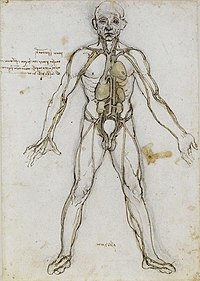
Photo from wikipedia
Objective The 2-point DIXON method is widely used to assess fat fractions (FFs) in magnetic resonance images (MRIs) of the tongue, pharyngeal wall, and surrounding tissues in patients with obstructive… Click to show full abstract
Objective The 2-point DIXON method is widely used to assess fat fractions (FFs) in magnetic resonance images (MRIs) of the tongue, pharyngeal wall, and surrounding tissues in patients with obstructive sleep apnea (OSA). However, the method is semiquantitative and is susceptible to B0 field inhomogeneities and R2* confounding factors. Using the method, although several studies have shown that patients with OSA have increased fat deposition around the pharyngeal cavity, conflicting findings was also reported in 1 study. This discrepancy necessitates that we examine the FF estimation method used in the earlier studies and seek a more accurate method to measure FFs. Materials and Methods We examined the advantages of using the GOOSE (globally optimal surface estimation) method to replace the 2-point DIXON method for quantifying fat in the tongue and surrounding tissues on MRIs. We first used phantoms with known FFs (true FFs) to validate the GOOSE method and examine the errors in the DIXON method. Then, we compared the 2 methods in the tongue, soft palate, pharyngeal wall, and parapharyngeal fat pad of 63 healthy participants to further assess the errors caused by the DIXON method. Six participants were excluded from the comparison of the tongue FFs because of technical failures. Paired Student t tests were performed on FFs to detect significant differences between the 2 methods. All measures were obtained using 3 T Siemens MRI scanners. Results In the phantoms, the FFs measured by GOOSE agreed with the true FF, with only a 1.2% mean absolute error. However, the same measure by DIXON had a 10.5% mean absolute error. The FFs obtained by DIXON were significantly lower than those obtained by GOOSE (P < 0.0001) in the human participants. We found strong correlations between GOOSE and DIXON in the tongue (R2 = 0.90), soft palate (R2 = 0.66), and parapharyngeal fat pad (R2 = 0.88), but the correlation was weaker in the posterior pharyngeal walls (R2 = 0.32) in participants. Conclusions The widely used 2-point DIXON underestimated FFs, relative to GOOSE, in phantom measurements and tissues studied in vivo. Thus, an advanced method, such as GOOSE, that uses multiecho complex data is preferred for estimating FF.
Journal Title: Investigative Radiology
Year Published: 2022
Link to full text (if available)
Share on Social Media: Sign Up to like & get
recommendations!